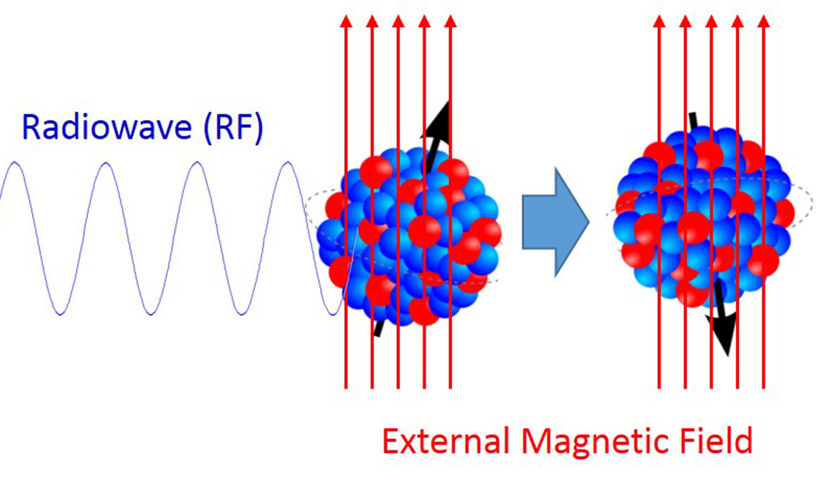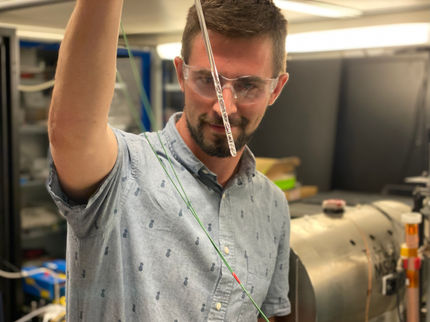Solution to the Hyperfine Puzzle in Reach
Measurements on Bismuth Nuclei bridge reported Gap
Last year, physicists at TU Darmstadt cast doubt on our current understanding of the interplay between electrons and atomic nuclei, and are now upping the ante by proposing a solution to this so-called “hyperfine puzzle”. New measurements of the magnetic properties of bismuth atomic nuclei are now published in an article in the “Physical Review Letters” journal.

Principle of measurement.
AG Nörtershäuser
The optical spectrum of any given atom is a result of the interplay between light and the electrons within the atomic shell. Ultra-precise measurements can even reveal the effects of the internal structure of the atomic nucleus, which are referred to as the “hyperfine structure”. When measuring the hyperfine structure of highly-charged ions with few remaining electrons, researchers at TU Darmstadt found a discrepancy between the theoretically predicted and experimentally determined splittings: these empirically observed discrepancies were referred to as the “hyperfine puzzle”, and raised the question as to whether the interplay between the few electrons bound to the atomic nucleus and the nucleus itself, under the influence of the prevailing enormously strong magnetic fields, is fully understood. The next step towards solving the puzzle was to re-determine the strength of the magnetic field within the atomic nucleus: theoretical predictions are strongly dependent on this parameter, which must be determined experimentally.
Physicists of the working groups of Prof. Wilfried Nörtershäuser and Prof. Michael Vogel from the Institute for Nuclear Physics and the Institute for Condensed Matter Physics, respectively, at the TU Darmstadt were collaborating to remeasure the strength of the magnetic field – the so-called magnetic moment – using nuclear magnetic resonance spectroscopy, which is used in medicine where it is referred to as MRI. It is based on the principle that atomic nuclei have a magnetic field, if they, like the bismuth isotope under investigation, have a nuclear spin. The north and south poles are oriented along the spin axis and will align with the magnetic field axis of an external magnetic field. The orientation of the nuclear magnets can be reversed by irradiating the atoms under investigation with radio waves of an appropriate frequency, and this effect can be observed. The frequency of the radio waves at which the poles change their direction depends upon the magnetic moment. Measuring the frequency allows one to deduce the value of the magnetic moment.
Measurement of the magnetic moment is affected
To achieve this, the researchers introduced an aqueous solution enriched with bismuth ions to a superconducting magnet and irradiated it with radio frequencies via a small coil until they registered a polarity reversal in the bismuth ions.
The challenge in doing this is that the ions’ environment, i.e., the atoms to which it is bound as well as the fluid in which it is dissolved, changes the external magnetic field in the vicinity of the atomic nucleus, which, in turn, affects the precise measurement of the magnetic moment. This disruptive effect has to be subtracted from the calculation, to which end highly specialised quantum-theoretical calculations were carried out by a group of theoretical physicists at the University of St. Petersburg and at the Helmholtz Institute Jena. It became apparent that the effect was much larger than previously expected when using bismuth-nitrate solutions, which means that measurements taken with the aid of bismuth-nitrate solutions are evidently inadequate.
The researchers finally achieved a breakthrough by using a complex organometallic compound, which releases hexafluoridobismuthate(V) ions in organic solution. The Darmstadt-based scientists received support from a research group specialised in fluorine chemistry at the University of Marburg, who produced a sample of the required substance. Thus, it was possible to measure much narrower resonance curves and to make more precise statements about the magnetic moment of the nucleus. Moreover, from the quantum-theoretical perspective, much more accurate calculations can be performed for this system than had previously been possible for bismuth nitrate.
The researchers used the newly calculated value for the magnetic moment of the stable bismuth isotope and made a theoretical prediction of the hyperfine structure splitting within the highly-charged ions. The values obtained, are in very good agreement with the results from the previously reported laser-spectroscopic measurements. “It would be too early to state that this represents the complete solution to the hyperfine puzzle,” Prof. Wilfried Nörtershäuser of the TU Darmstadt’s Institute for Nuclear Physics explains, going on to say; “nevertheless, it is for sure a significant part of the solution. Further experiments are still needed to achieve complete clarity about the interplay between the atomic nucleus and the shell and, therefore, to verify the theoretical predictions of the nature of quantum mechanics in very strong fields”. To better understand the complex influence of the electron shell on measurements of nuclear magnetic moments, scientists at TU Darmstadt now want to conduct measurements of nuclear magnetic moments on atomic nuclei with just a single bound electron or no electron shell at all. According to Nörtershäuser, such experiments are prepared at the GSI Helmholtz Centre for Heavy Ion Research in Darmstadt involving also other working groups from TU Darmstadt.
Original publication
Leonid V. Skripnikov, Stefan Schmidt, Johannes Ullmann, Christopher Geppert, Florian Kraus, Benjamin Kresse, Wilfried Nörtershäuser, Alexei F. Privalov, Benjamin Scheibe, Vladimir M. Shabaev, Michael Vogel, and Andrey V. Volotka; "New Nuclear Magnetic Moment of 209Bi – Resolving the Bismuth Hyperfine Puzzle"; Phys. Rev. Lett.; 120, 093001 – Published 27 February 2018
Other news from the department science
Most read news
More news from our other portals
See the theme worlds for related content
Topic World Spectroscopy
Investigation with spectroscopy gives us unique insights into the composition and structure of materials. From UV-Vis spectroscopy to infrared and Raman spectroscopy to fluorescence and atomic absorption spectroscopy, spectroscopy offers us a wide range of analytical techniques to precisely characterize substances. Immerse yourself in the fascinating world of spectroscopy!

Topic World Spectroscopy
Investigation with spectroscopy gives us unique insights into the composition and structure of materials. From UV-Vis spectroscopy to infrared and Raman spectroscopy to fluorescence and atomic absorption spectroscopy, spectroscopy offers us a wide range of analytical techniques to precisely characterize substances. Immerse yourself in the fascinating world of spectroscopy!





























































